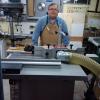In the middle of my first attempt to surfacing round tree slabs and am surprised at how quickly the bit went dull. I am curious as to whether it is me, or the router bit?
I have three slabs which I am surfacing both sides on each slab. The slabs are red oak about 16" diameter (97 years old so it is a dense tight end grain). The tree and slabs were cut about 10 years ago and the slabs have been stored inside and are dry & clean. I am using a CMT 852.503.11 Dado & Planer Bit, 1/2-Inch Shank, 1-1/4-Inch Diameter in an old Milwaukee 5670 router. The router is a fixed speed 26,000rpm which may be a bit fast for a 1-1/4" bit depending which chart I look at.
I started with a new bit. I am taking 1/16" cuts on each pass and the maximum that I have to take off each side to flatten the slabs is about 3/8". By the time I got started on slab #2 (side 3 of 6), the bit has gotten noticeably dull to where it is taking considerable increase in effort to both push the router and also keep the router from riding up due to the downward shear angle of the bit. And the bit is starting to burn the wood face. By the time I got to slab #3 the bit is shot and will not even take a 1/64" cut. I was not able to finish slab #3 with this bit. I have a lot of router and shaper bits. (Only 3 or 4 are CMT). I have never had a carbide router bit go dull like this. Most of my bits are 25-30 years old and still in great shape.
Is it normal to dull a bit this quick while surfacing round slabs? I plane my own wood and have no trouble with premature dulling of my planer blades so I am fairly certain if there were sand in these slabs that i would have realized it.




 Reply With Quote
Reply With Quote



